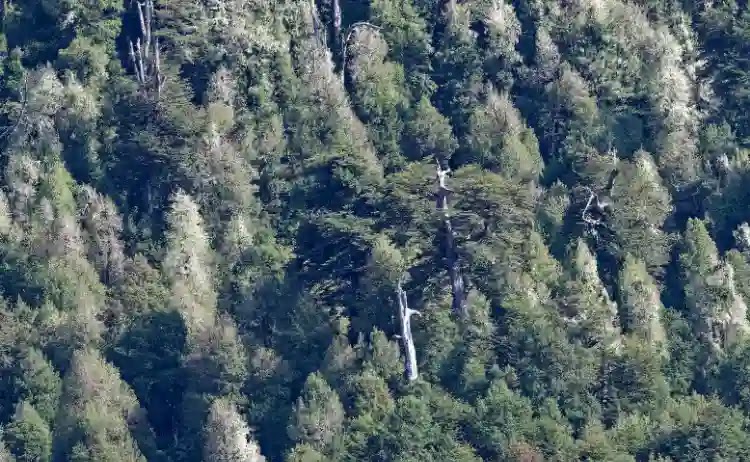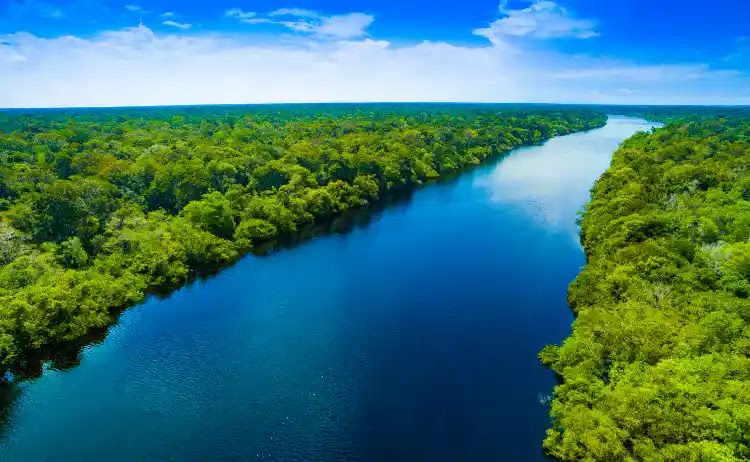Largest
Top 10 Largest Forests In The World
The world's largest forest, often regarded as one of Earth's most enigmatic and awe-inspiring wonders, is a vast realm of emerald green that stretches across continents and harbors secrets as old as time itself.
From the tangled and mysterious depths of the Amazon Rainforest, home to a mesmerizing array of species found nowhere else on Earth, to the hushed majesty of the Siberian Taiga, where ancient trees stand as silent sentinels of time.
ADVERT
These remarkable forests come in a range of forms, from the dripping canopies of tropical rainforests teeming with life to the tranquil and snow-covered landscapes of boreal forests, where the resilience of life against the harshest of winters is a testament to the wonders of adaptation.
Here we would like to share with you the top 10 largest forests in the world and their amazing biodiversity.
10. Bosawas Biosphere Reserve (20,000 Sqkm)
The Bosawas Biosphere Reserve, a remarkable natural wonder located in Nicaragua, is not only one of Central America's largest protected areas but also one of the most extensive biosphere reserves globally.
The reserve is celebrated for its extensive coverage, encompassing an area of approximately 20,000 square kilometers (7,722 square miles). The tropical forest is the most biologically diverse ecosystem on Earth, and it is estimated that Bosawas is home to approximately 13% of all known species worldwide.
The region is not only biologically rich but culturally significant as well. It is home to indigenous communities, including the Miskito and Mayangana peoples.
9. Myanmar Coastal Rain Forests (64,222 Sqkm)
The Myanmar Coastal Rain Forests, part of the Indo-Burma biodiversity hotspot, grace the eastern shores of Myanmar, bordering the Andaman Sea and the Gulf of Martaban. These rainforests cover an expansive area of approximately 64,222 square kilometers (24,796 square miles), making them one of the largest and most biodiverse rainforest ecosystems in Southeast Asia.
They host a wide variety of plant and animal species, many of which are endemic to the region. The forest is home to a range of unique flora, such as the critically endangered Burmese rosewood, and an array of wildlife, including the elusive clouded leopard and a plethora of bird species.
8. Tongass Forest (68,790 Sqkm)
The Tongass National Forest is located in the southeastern part of the U.S. state of Alaska. It spans a colossal area of approximately 68,790 square kilometers (26,560 square miles). Its vast expanse encompasses both mainland Alaska and numerous islands, and it stretches along the coastline of the Pacific Ocean.
The forest boasts an array of tree species, including Sitka spruce, western hemlock, and red cedar. The forest derives its name from a Tlingit Native American community. Its lush understory is adorned with blueberries, skunk cabbages, and an abundance of ferns and mosses.
ADVERT
The forest is inhabited by iconic Alaskan wildlife, such as brown bears, bald eagles, and the highly sought-after Sitka black-tailed deer.
7. Atlantic Forest (100,000 Sqkm)
The Atlantic Forest, often referred to as the "Mata Atlântica" in Portuguese, is a vast and highly diverse biome in South America. The Atlantic Forest stretches along the eastern coast of South America, encompassing parts of Brazil, Argentina, and Paraguay.
This forest biome is extensive, covering an area of approximately 100,000 million square kilometers (38,610 square miles). In the past, the Atlantic Forest spanned an area of more than 1.2 million square kilometers, roughly a quarter of the Amazon's size.
However, after centuries of deforestation for purposes such as logging, sugar cane, coffee, cattle ranching, and urban expansion, the Atlantic Forest has shrunk by over 90%. Today, less than 100,000 square kilometers of this once-expansive forest remain.
6. Valdivian Temperate Forest (166,248 Sqkm)
The Valdivian Temperate Rainforest, nestled along the western coast of South America, is an awe-inspiring and extensive natural treasure. The Valdivian Temperate Rainforest blankets regions of Chile and Argentina and is named after the Chilean city of Valdivia.
This rainforest is known for its vast coverage, encompassing an area of approximately 166,248 square kilometers (64,188 square miles). Within these forests lies the unique monkey puzzle tree (Araucaria araucana), a species that has existed since the era of dinosaurs.
They also house the world's second-oldest living entity: the endemic alerce conifer (Fitzroya cupressoides), capable of surviving for up to 3,600 years while attaining dimensions of 5 meters in diameter and soaring to heights of 60 meters.
5. Appalachian Rainforest (350,000 Sqkm)
The Appalachian Rainforest, also known as the Appalachian Temperate Rainforest, is a lesser-known but remarkable ecological treasure nestled in the eastern United States. This temperate rainforest spans a diverse range of environments and landscapes, from lowland swamps to high-altitude, moss-draped forests.
The Appalachian Rainforest is a temperate rainforest covering a more modest area of around 350,000 square kilometers (135,100 square miles). The forest consists of hardwoods such as oak, hickory, and maple, as well as conifers like hemlock and spruce. It is home to a wide array of plant and animal species adapted to the temperate climate.
ADVERT
It is inhabited by a variety of mammals, including black bears, white-tailed deer, and gray wolves. The forest is also home to unique salamander species and a rich diversity of birdlife.
4. Borneo Lowland Rainforests (428,438 Sqkm)
Borneo, the world's third-largest island, is divided among three nations: Indonesia, Malaysia, and Brunei. The Borneo Lowland Rainforests are primarily found in the Malaysian states of Sabah and Sarawak, as well as the Indonesian provinces of Kalimantan.
These lowland rainforests cover an expansive area of approximately 428,438 square kilometers (165,420 square miles), making them one of the largest continuous tracts of lowland rainforest remaining in Southeast Asia.
They house a remarkable array of plant and animal species, many of which are endemic to the region, meaning they are found nowhere else on Earth. Iconic wildlife such as orangutans, pygmy elephants, and hornbills call this rainforest home.
Not just that, the lowland rainforest is also one of the oldest ones out there which was believed to have existed roughly 140 million years ago. Due to mass deforestation, the forest is rapidly shrinking in size and will continue at an alarming rate if no changes are made.
3. New Guinea Rainforest (786,000 Sqkm)
New Guinea, the world's second-largest island, is home to one of the most expansive and diverse rainforests on the planet. The New Guinea Rainforest boasts a massive land area of 786,000 square kilometers (303,500 square miles) making it the largest forest in Asia.
Its lush green canopy shelters an astonishing array of plant and animal species, including many that are unique and found nowhere else on Earth. From tree kangaroos to colorful birds of paradise, this rainforest is a living treasure trove of biological diversity.
It encompasses lowland rainforests, montane forests, swamps, and mangroves, each hosting its own unique ecosystems and species. It is home to more than 1,000 indigenous tribes and is comprised of up to 10% of all animal species on earth.
2. Congo Rainforest (3.7 Million Sqkm)
The Congo Rainforest, often referred to as the "Green Heart of Africa," is another of the world's most massive and ecologically important forests. The Congo Rainforest is the world's second-largest tropical rainforest, covering an astounding expanse of approximately 3.7 million square kilometers (1.4 million square miles).
This colossal area spans multiple countries in Central Africa, primarily the Democratic Republic of the Congo (DRC), but also parts of Gabon, Cameroon, the Republic of the Congo, the Central African Republic, and Equatorial Guinea.
ADVERT
The Congo Rainforest is home to a vast array of flora and fauna, including rare and endemic species. It is the habitat for iconic animals such as gorillas, chimpanzees, bonobos, forest elephants, and okapis, along with countless bird and insect species.
On top of that, It is also home to numerous indigenous communities and traditional societies that have thrived in harmony with the forest for generations. These communities maintain invaluable knowledge about the forest's resources and medicinal plants.
1. Amazon Rainforest (5.5 Million Sqkm)
The Amazon Rainforest is a place of superlatives, and its vast size stands as a testament to the grandeur of the natural world. Often referred to as the "Lungs of the Earth," the Amazon is the largest tropical rainforest on the planet, and its sheer scale is awe-inspiring.
The Amazon Rainforest sprawls across a staggering expanse, covering approximately 5.5 million square kilometers (2.1 million square miles). This immense area is roughly equivalent to the combined size of the contiguous United States and nearly the entire European Union.
The Amazon spans nine South American countries, with the majority (around 60%) located in Brazil. Within its boundless green canopy, the Amazon hosts an unparalleled diversity of life. It is estimated that the region is home to approximately 390 billion individual trees belonging to around 16,000 species.
Also read: Top 7 Oldest Forest In The World



















Post a Comment
0 Comments